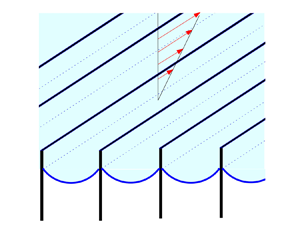Crossref Citations
This article has been cited by the following publications. This list is generated based on data provided by
Crossref.
Miyoshi, Hiroyuki
Rodriguez-Broadbent, Henry
Curran, Anna
and
Crowdy, Darren
2022.
Longitudinal flow in superhydrophobic channels with partially invaded grooves.
Journal of Engineering Mathematics,
Vol. 137,
Issue. 1,
Mayer, Michael D.
and
Crowdy, Darren G.
2022.
Superhydrophobic surface immobilisation by insoluble surfactant.
Journal of Fluid Mechanics,
Vol. 949,
Issue. ,
Ren, Liuzhen
Hu, Haibao
Bao, Luyao
Priezjev, Nikolai V.
Wen, Jun
and
Xie, Luo
2022.
Two local slip modes at the liquid–liquid interface over liquid-infused surfaces.
Physics of Fluids,
Vol. 34,
Issue. 8,
Батюк , Лілія
and
Кізілова , Наталія
2022.
УЗАГАЛЬНЕНІ РІВНЯННЯ РУХУ РІДИН І ЗВ’ЯЗАНІ ФІЗИЧНІ ПРОЦЕСИ ПЕРЕНОСУ НА МІКРО- І НАНОРІВНІ.
Grail of Science,
p.
102.
Kizilova, Natalya
2023.
Nanomaterials and Nanocomposites, Nanostructure Surfaces, and Their Applications.
Vol. 279,
Issue. ,
p.
43.
Skvortsov, Alexei T.
Grebenkov, Denis S.
Chan, Leon
and
Ooi, Andrew
2023.
Slip length for a viscous flow over spiky surfaces.
Europhysics Letters,
Vol. 143,
Issue. 6,
p.
63001.
Yariv, Ehud
2023.
Effective slip length for longitudinal shear flow over partially invaded grooves: Small solid-fraction approximations.
Physical Review Fluids,
Vol. 8,
Issue. 1,
Yariv, Ehud
2023.
Highly singular slip length for longitudinal shear flow over a dense bubble mattress.
Journal of Fluid Mechanics,
Vol. 967,
Issue. ,
Yariv, E.
2023.
Effective slip length for transverse shear flow over partially invaded grooves.
Journal of Fluid Mechanics,
Vol. 957,
Issue. ,
Yu, Ning
Li, Zhaohui “Ray”
McClelland, Alexander
del Campo Melchor, Francisco Jose
Lee, Sun Youb
Lee, Jae Hwa
and
Kim, Chang-Jin “CJ”
2023.
Sustainability of the plastron on nano-grass-covered micro-trench superhydrophobic surfaces in high-speed flows of open water.
Journal of Fluid Mechanics,
Vol. 962,
Issue. ,
Miyoshi, Hiroyuki
Kirk, Toby L.
Hodes, Marc
and
Crowdy, Darren G.
2024.
Fully developed flow through shrouded-fin arrays: exact and asymptotic solutions.
Journal of Fluid Mechanics,
Vol. 991,
Issue. ,
Ren, Liuzhen
Zhang, Mengzhuo
Hu, Haibao
Wen, Jun
and
Xie, Luo
2024.
Transition of slip mode at gas–liquid interface formed by wettability steps on an superhydrophobic surface.
Ocean Engineering,
Vol. 294,
Issue. ,
p.
116823.
Crowdy, Darren G.
2024.
Torque-driven superhydrophobic cylinders swim in circles.
Proceedings of the Royal Society A: Mathematical, Physical and Engineering Sciences,
Vol. 480,
Issue. 2300,
Yan, Zihan
and
Kowal, Katarzyna N.
2024.
A controllable sliding law for thin-film flows over slippery fluid-saturated substrates: theory and experiments.
Journal of Fluid Mechanics,
Vol. 982,
Issue. ,
Liu, Honglin
Jacob, Karl I.
and
Wang, Youjiang
2024.
Scaling in membrane distillation (MD): Current state of art insight on mechanisms and Membrane design.
Desalination,
Vol. 581,
Issue. ,
p.
117539.
Yariv, Ehud
2024.
Longitudinal Shear Flow over a Superhydrophobic Grating with Partially Invaded Grooves and Curved Menisci.
SIAM Journal on Applied Mathematics,
Vol. 84,
Issue. 3,
p.
1186.
Rahmani, Hossein
Larachi, Faïçal
and
Taghavi, Seyed Mohammad
2024.
Modeling of Shear Flows over Superhydrophobic Surfaces: From Newtonian to Non-Newtonian Fluids.
ACS Engineering Au,
Vol. 4,
Issue. 2,
p.
166.
Yu, Ning
del Campo Melchor, Francisco Jose
Li, Zhaohui “Ray”
Jeon, Jihun
Eldredge, Jeff D.
and
Kim, Chang-Jin “CJ”
2024.
Drag reduction on micro-trench and micro-post superhydrophobic surfaces underneath a motorboat on the sea.
Flow,
Vol. 4,
Issue. ,
Mohammadshahi, Shabnam
O'Coin, Daniel
and
Ling, Hangjian
2024.
Impact of sandpaper grit size on drag reduction and plastron stability of super-hydrophobic surface in turbulent flows.
Physics of Fluids,
Vol. 36,
Issue. 2,
Zimmermann, Sebastian
Schönecker, Clarissa
and
Crowdy, Darren G.
2025.
Pressure-driven flow through superhydrophobic pipes with general patterns of longitudinal no-shear stripes.
Journal of Fluid Mechanics,
Vol. 1009,
Issue. ,



